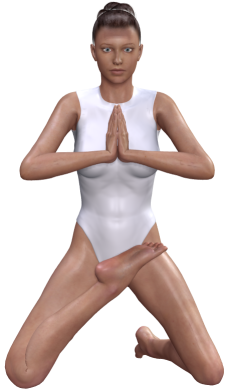Vatayanasana - The Horse
Introduction
Possible etymological roots:
- वात vata {from va}: wind, air, breath, vital breath | myth. Vata, epith. of the God Vayu "Who breathes" || Lat. ventus; engl. wind; Fr. vent.
- अयन ayana {from aya-na}: way, pathway, | astr. half-year (sun's pathway from one solstice to the other).
- vâta-ayana, a. moving in the wind or air; n. air-hole, round window; airy part of a house, balcony, portico, terrace on the roof.
Synonyms: Leg Raises, Horse, Wind Relieving
Presentation
This practice mainly involves the heart center.
The half horse
The starting point is in half lotus. The hands are in Anjali Mudra and the body is straight. The tongue is in Kaki Mudra. The three bandhas are applied during the whole posture: Mula Bandha, Uddiyana Bandha and Jalandhara Bandha.
Note: the more the supporting leg is brought towards the knee, the more difficult the balance and the more intense the posture. The pelvis must be brought forward and the trunk is vertical to have the heart as frontward as possible. In this posture, the eyelids are closed all along. If this is too difficult, they are open, with the eyes fixing a real or virtual point. However, this last suggestion should be only temporary.
The breathing follows visamavritti. It is also possible to add Kaki Mudra during the inhalation. During the other phases of the breathing, the tongue sticks to the soft palace and the breathing occurs through the nostrils.
Example of basic rhythm
- Tongue inside in kaki. Deep exhalation without movement.
- Tongue outside in kaki. Inhalation [4]
- Tongue inside. Full retention [16]
- Tongue inside on soft palate. Exhalation [8]
- Tongue outside in kaki. Inhalation [4]
- And so forth
- etc. …
Complete Version
In this version the foot is used as support, and not the knee:
This version is much more demanding. However, the energy and breathing works are identical. The breathing should be increased to 5/10/20, 6..., 7... and even more according to individual possibilities.
Note: Use a pillow under the supporting knee in both versions to protect the joint.

